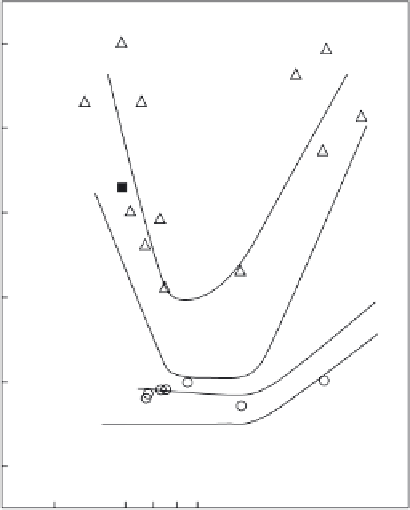Environmental Engineering Reference
In-Depth Information
60
4 cycles
50
40
3 cycles
30
20
2 cycles
1 cycle
10
Each point is the average
from several fuel rods
0.03
0.05
0.1
0.2
0.3
Average precipitate size (m)
4.47
Effect of SPP size on corrosion of Zircaloy-2 cladding. (Source:
Reprinted, with permission, from Garzarolli
et al
. (1994), copyright
ASTM International, 100 Barr Harbor Drive, West Conshohocken, PA
19428.)
Zircaloy-4, which does not contain alloying quantities of Ni, is also
susceptible to increased corrosion when SPPs dissolve. An example is given
in Fig. 4.42 for Zircaloy-4 with a relatively large SPP, about 0.2 µm average
size determined by TEM (Garzarolli,
et al
., 2002). It is seen that when the
volume fraction of SPPs gets very low, corrosion increases dramatically.
A compilation of data for Zircaloy-2 and -4 given by Garzarolli in
Adamson
et al
. (2006) and Garzarolli
et al
. (2011b) illustrates that Zircaloy-4
generally has higher corrosion than Zircaloy-2 (see Fig. 4.49). However, the
hydrogen pickup fraction (HPUF) for Zircaloy-4 appears to stay remark-
ably low at high burnup, as indicated by the data of Miyashita
et al
. ( 2006 )
and the correlation given in Fig. 4.50 .
In PWRs nodular corrosion in unlikely to occur due to high hydrogen
and low oxygen in the water. Accelerated uniform corrosion does occur for
Zircaloy-4 in PWRs as seen in Fig. 4.51 (and Fig. 4.48) and the HPUF is rel-
atively low, as in BWRs (Fig. 4.52).Those fi gures also show that M5 (which is
basically a Zr1Nb alloy with 300-500 ppm Fe) does not undergo accelerated













Search WWH ::

Custom Search